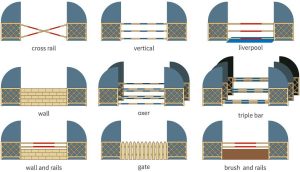Types of Show Jumps
Have you ever watched the show jumping, amazed at the horses and riders leaping over huge obstacles that put instant fear into the rest of us mere mortals, and wondered what the difference between the fences actually were? In today’s blog we brush up on all the types of fences you may encounter in the show jumping arena.
Not all show jumps are the same, some are wider, taller, and angled- lets go through the different types and their names.
- Verticals – Consists of rails placed directly above each other, they range in height depending on the level and there is no width or spread. They can also have fill inserted such as a plank or gate.
- Oxers – often referred to as spreads, Oxers are two jumps placed together to increase the height and width, according to the level being jumped. There are several different types of oxers.
- If the top rails of both jumps are the same height it is called a square or box oxer.
- If the second rail is slightly higher this is an ascending or ramped oxer
- If the front rail is higher this is a descending oxer (these are not often seen in competition and not used in FEI events for safety reasons).
- The last type is the Swedish oxer where the front and rear poles are slanted in opposite directions creating like a X in the middle.
- Triple Bars – Involves three elements gradually increasing in height from front to back. Once again height and width vary depending on level. Much more challenging than the oxer.
- Cross Rails – These are not often seen in competition only at the lower levels if at all. Generally used for schooling and education. They are two rails crossed over to create a lower height in the middle, encouraging the horse to jump directly in the centre of the jump.
- Walls – consists of bricks made from lightweight material that easily fall if knocked down by the horse whilst jumping. Can either be constructed of just the bricks, or can have a rail placed on top.
- Combinations – Two fences (double) or three fences (triple) placed in a row with no more than two strides between them. The fences may be the same type of jump or consist of a vertical and oxer depending on the level.
- Water Jumps – These aren’t very high but are wide, built using a tray of water that must be cleared by the horse.
- Liverpool – Is a combination of an oxer and a water jump. A tray of water (or substitute) is placed underneath the jump (oxer) creating height and width.
- Joker – Generally only used at the higher levels. They may be unpainted or more plain/simple jumps, with no fill, which makes the fence slightly more challenging.
There are also different types of what is called ‘fill’ that can be added to many of these jumps which we touched on earlier. These can include objects such as a brush, planks, and gates, which add different perspectives and dimensions to the fences.
Below is a diagram showing the different types of fences which may make it slightly easier to recognise them when you are next out and about.

Written by Selena P.
Image Reference:
https://equestrianspace.com/how-many-jumps-are-in-a-show-jumping-course/
Experts in Equine Nutrition
Every product in the Ranvet range has been developed to meet a horse’s most specific need at any given time, be it in a training environment or on a breeding farm. Having pioneered the formulation of specific medications and dietary supplements for horses, the company is now recognised as a leader in the areas of equine health and nutrition.
